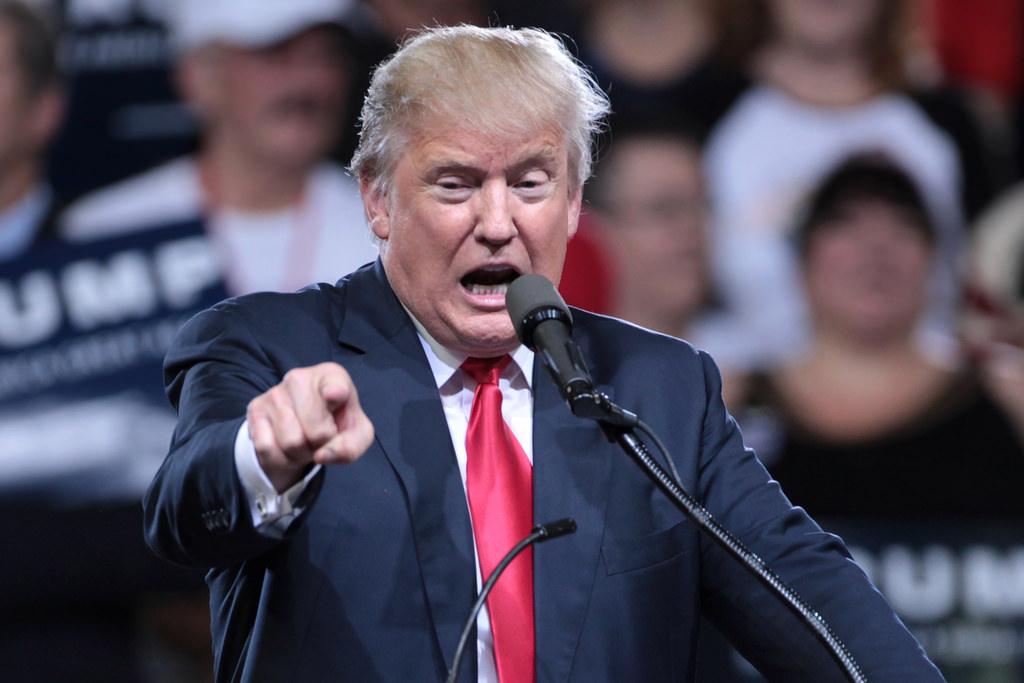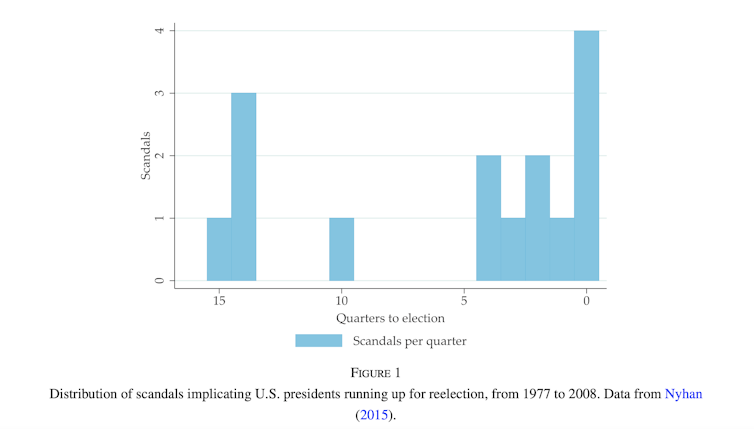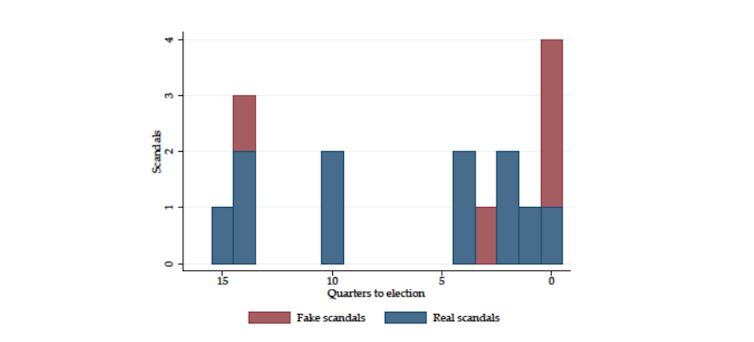It’s unlikely The New York Times’ publication of Donald Trump’s tax records just before the first presidential candidates’ debate was a coincidence.
This looks like a classic example of what political scientists and commentators call an “October Surprise” – a news story deliberately timed to influence the US presidential election.
Much is at stake – the presidency, as well the entire House of Representatives and one-third of the Senate. What is in the minds of voters before they vote is crucial. This gives interested parties great incentive to strategically time the release of information they might have been holding on to for some time.
A well-timed “bombshell” can sway the outcome. But what is the best timing? The first Tuesday in November is still a long way off. Why not wait?
Remember what happened last election
Remember 2016, when both Trump and rival Hillary Clinton faced last-minute scandals.
Trump had his “Access Hollywood tape”, featuring him talking crudely about women. The Washington Post published the tape on October 7, two days before his second debate with Clinton. Given the recording was from 2005, it is hard to conclude the timing of the Post’s publication wasn’t strategic – if not by the newspaper then by the source of the material.
But this October Surprise arguably proved far less damaging than the bombshell that hit Clinton just 11 days before the election, when FBI director James Comey announced the bureau was reopening its investigation into Clinton’s use of a private email server while US Secretary of State.
The FBI had previously investigated and deemed Clinton and her team extremely careless in not using secure government emails to handle classified information. But it recommended no charges. The case was reopened when more emails, sent by Clinton aide Huma Abedin on the laptop of her husband Anthony Weiner, were found. Making the story even juicier was that the FBI found the emails while investigating Weiner for sending sexually explicit messages to a 15-year-old girl.
While there is no suggestion Comey’s announcement was a deliberate October Surprise, its timing certainly didn’t help Clinton. Nothing came of the reopened case. Had Comey made the announcement a few weeks earlier, the election might have gone to Clinton.
Credibility versus scrutiny
The superficial lesson from 2016 might appear to be that the closer to the election you can drop a bombshell, the better.
Indeed analysis of political scandals since the late 1970s show more occur with as as an election get closer.
Gabriele Gratton, Richard Holden and Anton Kolotolin, 'When to Drop a Bombshell', Review of Economic Studies, 85(4), 2018: 2139-2172.
But too many scandals bunched too close to an election is likely to blunt their impact. Voters might rationally assume scandals are more likely to be fake the closer they erupt to election day. They have good reason to be sceptical. It is also rational for anyone wanting to influence the outcome with fake news to deny voters the time to distinguish between fact and fiction.
So when is the best time to drop a bombshell for maximum impact?
My analysis with colleagues Gabriele Gratton and Anton Kolotilin (in the Review of Economic Studies) shows fake scandals are more likely closer to elections. This includes “Billygate” claims in October 1980 that President Jimmy Carter’s brother Billy was a Libyan agent of influence, and “Filegate” claims in 1996 the Clinton White House had improperly acquired access to FBI files on political opponents.
Distribution of real and fake scandal claims concerning US presidents and candidates. Gratton, Holden and Kolotilin (2017), 'When to Drop a Bombshell',, CC BY-NC-ND
So there is a strategic trade-off between credibility and scrutiny.
On the one hand, dropping the bombshell earlier is more credible, in that it signals that its sender has nothing to hide. On the other hand, it exposes the bombshell to scrutiny for a longer period of time — possibly revealing that the bombshell is a fake.
Time adds credibility
What, then, to make of the New York Times’ bombshell on September 27, two days before Trump’s first debate with Joe Biden, that:
Donald J. Trump paid [US]$750 in federal income taxes the year he won the presidency. In his first year in the White House, he paid another [US]$750.
He had paid no income taxes at all in 10 of the previous 15 years — largely because he reported losing much more money than he made.
Only the Times knows when it first could have run this story. But it has released its story far enough before election day that there is time for a good deal of scrutiny. Given the nature of the story, the newspaper’s claims are likely to be proven true or false quickly. The lead time is reason to have confidence in the story’s accuracy.
Adding to the story’s credibility is what economists call a high “prior belief” about Trump being someone who lies and cheats.
We can probably count on more than a few more bombshells about Trump or Biden as November 3 draws closer.
But the basic strategic considerations highlighted by our model suggests the closer a bombshell drops to election day a bombshell drops, the greater the reason to question its credibility.



 RBA Signals Possible Interest Rate Hike in 2026 as Inflation Pressures Persist
RBA Signals Possible Interest Rate Hike in 2026 as Inflation Pressures Persist  U.S. Stocks Rally to Record Highs as AI Rebound Fuels Holiday-Shortened Session
U.S. Stocks Rally to Record Highs as AI Rebound Fuels Holiday-Shortened Session  China’s Power Market Revamp Fuels Global Boom in Energy Storage Batteries
China’s Power Market Revamp Fuels Global Boom in Energy Storage Batteries  Israel Advances Controversial Inquiry Bill Into October 7 Hamas Attack Amid Public Backlash
Israel Advances Controversial Inquiry Bill Into October 7 Hamas Attack Amid Public Backlash  U.S. Coast Guard Faces Resource Strain as It Pursues Venezuela-Linked Oil Tanker
U.S. Coast Guard Faces Resource Strain as It Pursues Venezuela-Linked Oil Tanker  U.S. Shifts Strategy Toward Economic Pressure With Venezuelan Oil Quarantine
U.S. Shifts Strategy Toward Economic Pressure With Venezuelan Oil Quarantine  U.S. Prioritizes Economic Pressure With Venezuelan Oil Quarantine as Sanctions Intensify
U.S. Prioritizes Economic Pressure With Venezuelan Oil Quarantine as Sanctions Intensify  Global Markets Rise as Tech Stocks Lead, Yen Strengthens, and Commodities Hit Record Highs
Global Markets Rise as Tech Stocks Lead, Yen Strengthens, and Commodities Hit Record Highs  Australia Moves Toward Tougher Gun Laws After Bondi Shooting
Australia Moves Toward Tougher Gun Laws After Bondi Shooting  Democratic Governors Urge Trump Administration to Lift Halt on East Coast Offshore Wind Projects
Democratic Governors Urge Trump Administration to Lift Halt on East Coast Offshore Wind Projects  US and Japan Fast-Track $550 Billion Strategic Investment Initiative
US and Japan Fast-Track $550 Billion Strategic Investment Initiative  NSW Passes Toughest Gun and Anti-Terror Laws After Bondi Beach Shooting
NSW Passes Toughest Gun and Anti-Terror Laws After Bondi Beach Shooting  Gold Price Breaks $4,500 as Safe-Haven Demand and Rate Cut Bets Fuel Rally
Gold Price Breaks $4,500 as Safe-Haven Demand and Rate Cut Bets Fuel Rally  Oil Prices Ease in Asia as Geopolitical Risks Clash With Weak Demand Outlook
Oil Prices Ease in Asia as Geopolitical Risks Clash With Weak Demand Outlook  Asian Markets Rise as AI Rally Caps 2025, Gold and Silver Hit Record Highs
Asian Markets Rise as AI Rally Caps 2025, Gold and Silver Hit Record Highs  Taiwan Stock Market Ends Higher as Semiconductor and Energy Shares Lead Gains
Taiwan Stock Market Ends Higher as Semiconductor and Energy Shares Lead Gains  Oil Prices Edge Higher as Strong U.S. Growth and Supply Risks Support Market
Oil Prices Edge Higher as Strong U.S. Growth and Supply Risks Support Market 


































